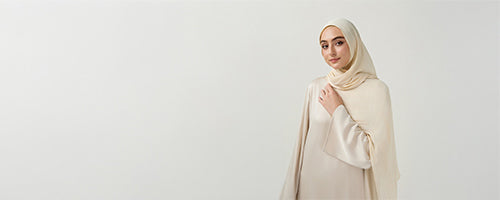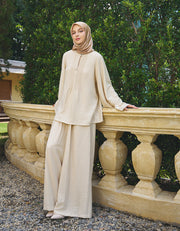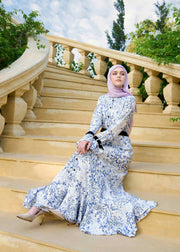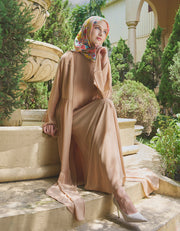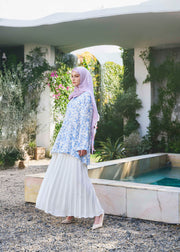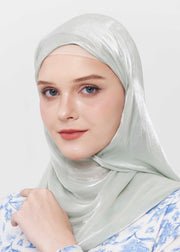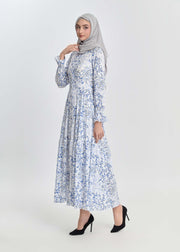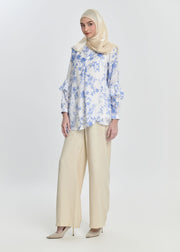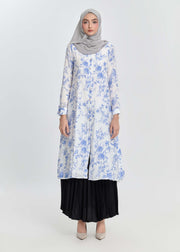The Meaning of Color in Islamic Fashion: A Comprehensive Guide
Color plays an essential role in how we express identity, faith, and beauty. In Islamic fashion, color is not just an aesthetic choice—it carries deep cultural, historical, and even spiritual meanings. Every hue, from vibrant green to soft beige, reflects values of modesty, respect, and individuality. This guide explores the meaning of color in Islamic fashion and how these shades have evolved within modest wear today.
The Symbolic Meaning of Color in Islamic Fashion
Throughout Islamic history, colors have held significant spiritual and cultural importance. They are often tied to the environment, religion, and social expression.
-
Green, for instance, is regarded as the most sacred color in Islam. It is associated with paradise, renewal, and peace. It has long been a preferred color in Islamic clothing, symbolizing hope and prosperity.
-
White represents purity and simplicity. Many Muslims wear white for religious events, symbolizing peace and equality.
-
Black, commonly seen in abayas and jilbabs, embodies modesty, dignity, and timeless elegance.
-
Blue evokes calmness and spiritual reflection, while gold adds a touch of nobility and divine light.
In modern Islamic fashion, these colors continue to influence design while adapting to contemporary tastes.
Traditional vs. Modern Interpretations of Color in Islamic Fashion
Historically, color in Islamic fashion was closely tied to geography and tradition. People living in warmer regions often preferred lighter tones such as beige, ivory, and white for practicality. In contrast, darker shades were more common in cooler climates.
Today, Islamic fashion designers reinterpret these traditions by combining them with modern trends. For instance:
-
Neutral colors remain central to minimalist modest fashion.
-
Pastel hues like blush pink or lavender are now popular among younger Muslim women for their feminine and refreshing touch.
Designers also experiment with bold colors in Islamic fashion, such as emerald green, burgundy, and navy blue, proving that modesty can coexist with creativity.

Traditional vs. Modern Interpretations of Color in Islamic Fashion
How Color in Islamic Fashion Reflects Modesty and Identity
In Islamic dress, modesty is not only about coverage but also about demeanor and self-expression. The color of one’s clothing can communicate confidence, humility, and respect without compromising faith-based values.
Soft and neutral tones often suggest humility and simplicity, aligning perfectly with the concept of haya (modesty). Meanwhile, rich tones—like deep plum or teal—allow Muslim women to express personality while maintaining elegance. The key is balance: choosing colors that reflect one’s identity without drawing excessive attention.
For many women, color in Islamic fashion becomes a way to celebrate individuality within the boundaries of modesty. It allows them to express emotion, mood, and creativity in a dignified way.
Color Psychology in Islamic Clothing
Color psychology influences how we perceive and react to different hues. Within Islamic fashion, these meanings blend beautifully with faith-based symbolism:
-
Green: Serenity, faith, and spiritual harmony.
-
Black: Strength, sophistication, and protection.
-
White: Purity, innocence, and clarity of mind.
-
Brown and Earth Tones: Stability, warmth, and groundedness.
-
Blue: Reflection, inner peace, and tranquility.
Understanding these associations helps Muslim fashion enthusiasts choose colors that align not only with trends but also with emotional and spiritual balance.

Color Psychology in Islamic Clothing
Seasonal and Cultural Trends of Color in Islamic Fashion
Each season brings a new wave of color trends in Islamic fashion.
-
Spring/Summer: Soft tones like mint, peach, and ivory dominate, creating a fresh, airy look suitable for warmer days.
-
Autumn/Winter: Rich shades—burgundy, chocolate, and forest green—add depth and comfort to layered outfits.
Cultural diversity also shapes these preferences. In Southeast Asia, for example, bright and floral colors reflect tropical vibrance. In the Middle East, black and beige remain timeless for their elegance and modest appeal.
Global Islamic fashion brands are now blending these regional aesthetics, offering a full palette of color choices for the modern modest dresser.
Choosing the Right Color for Your Modest Wardrobe
When building a modest wardrobe, it’s essential to select colors that complement your skin tone, personality, and lifestyle. Here are some simple guidelines:
-
For everyday wear: Opt for neutral shades like beige, white, or soft gray for versatility.
-
For special occasions: Jewel tones such as emerald, ruby, or sapphire enhance elegance.
-
For layering: Mix light and dark tones for balance—like a cream hijab over a navy abaya.
Remember, the right color in Islamic fashion enhances your look while maintaining the essence of modesty and grace.

Choosing the Right Color for Your Modest Wardrobe
Conclusion: Embracing Diversity Through Color in Islamic Fashion
The beauty of Islamic fashion lies in its harmony between tradition and modernity. Color serves as a bridge that connects faith, culture, and creativity. Whether you prefer minimalist whites or vibrant jewel tones, every shade tells a story about identity, spirituality, and empowerment.
By understanding the meaning of color in Islamic fashion, you can build a wardrobe that reflects both your beliefs and your personal style—an elegant balance that truly defines modern modest fashion.
If you’re looking for color-rich, elegant, and high-quality modest pieces inspired by faith and femininity, explore the full collection at Minnaba — where modest fashion meets timeless elegance.

